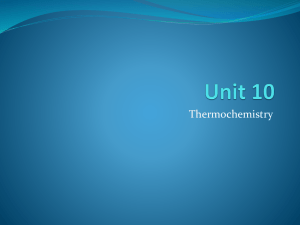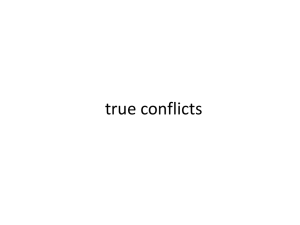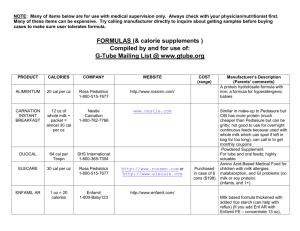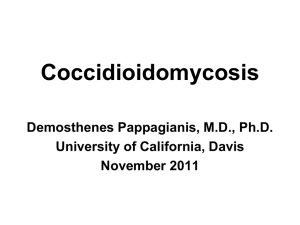FEEDING THE WORLD
advertisement
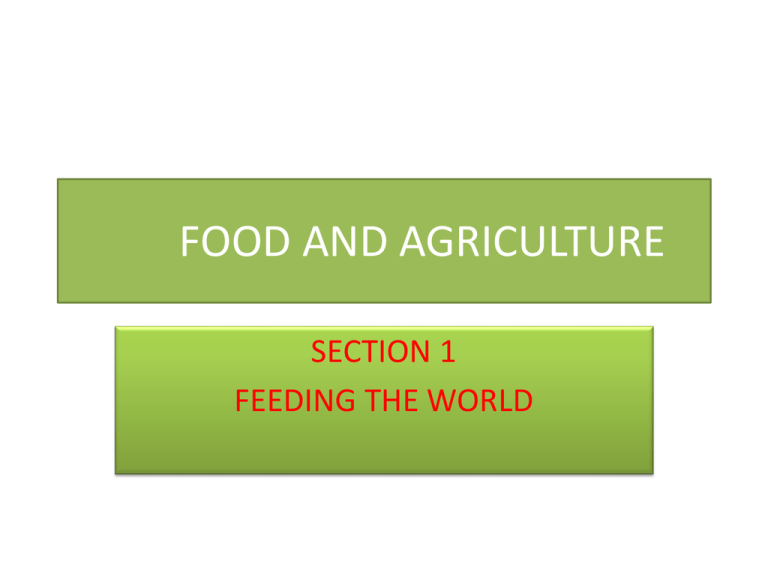
FOOD AND AGRICULTURE SECTION 1 FEEDING THE WORLD Challenges for 21st Century • • • • Reduce global hunger (food security) Meet world food demand with sustainable agricultural practices Food safety OVERVIEW Feeding the world • This chapter will discuss food production, maintenance of soil productivity, and the challenges of feeding the world. • Various alternative methods of planting and harvesting crops, controlling pests, and raising livestock are examined. Warm-up • Imagine you are the owner of this farmland in rural Pennsylvania. • What might their daily life involve? • What concerns and needs would they have in order to maintain their income and way of life? • Today less than 10% of agricultural land in the United States is owned and operated by families. Work with your partner and brainstorm possible reasons for this situation Objectives • Identify the major causes of malnutrition • Compare the environmental costs of producing different types of food. • Explain how food distribution problems and drought can lead to famine • Explain the importance of green revolution Humans and Nutrition • Food serves as a source of energy and also serves as a source materials for building and maintaining body tissues. Major nutrients in Human Foods Nutrient Composition Sources Energy Yield Function Carbohydrates Sugars Wheat, corn, and rice 4 cal/g Is the main source of the body’s energy Lipids (oil and fats) Fatty acids and fatty alcohol Olives, nuts, and animal fats 9 Cal/g Helps from membranes and hormones Proteins Amino acids Animal food and smaller amounts from plants About 4 Cal/g Helps build and maintain all body structures Population Growth Malnutrition Things to ponder • Hypothesize why everyone does not get enough food • Malnutrition is a condition that occurs when people do not consume enough Calories or do not eat a sufficient variety of foods to fulfill all of the body’s needs. • In some parts of the world, the only sources of food may be corn or rice. Each of these food contains proteins but lacks one of the essential amino acids. Food choices if for the same amount of money, you could buy three loaves of bread or this one hamburger patty, which would choose and why? Hamburger patty Whole grain bread Refer to the graph in page number 380 in your text book and answer the following Discuss with your partner and be prepared to answer Why do you think proteins and fats form a larger percentage of the diets of western, developed countries, and less in developing countries? In the United States, almost half of all Calories people consume come from meat, fish, and oil. Japanese diet traditionally included rice, vegetables, and seafood, have started to consume beef in recent decades. A healthy diet • A healthy diet is one that maintains a balance of the right amounts of nutrients, minerals, and vitamins. • In most parts of the world, people east large amounts of food that is high in carbohydrates, such as rice, potatoes and bread. • The food produced in the greatest amounts all over the world are grains, whose seeds are rich in carbohydrates. Besides eating grains, most people east fruits, vegetables, and smaller amounts of nuts, meats, and other food rich in fat and proteins. Food efficiency • The efficiency of a given type of agriculture is a measure of the quantity of food produced on a given area of land with limited inputs of energy and resources. • An ideal food crop is one that efficiently produces a large amount of food with little negative impact on the environment. • A given area of land can usually produce more food for humans when it is used to grow plants than when it is used to raise animals. Can you give reasons? • Meat from animals generally provides more nutrients pr gram than most food from plants. Math Practice Extra calories An active man who weighs 70 kg maintains his weight if he eats 2,700 Cal per day. Unused calories are converted into stored fat at the rate of 1 kg of fat per 9,000 Cal that are unused. If this active man consumes 3,600 cal per day, how much weight does he gain each year? Solution • 3,000 Cal/day – 2,700 Cal/day = 900 Cal/day • 900 Cal/day x 365 days/year = 328,500 Cal/year • 328,500 Cal/year÷ 9,000 = 36.5 kg weight gained /year • (1 kg of fat per 9,000 Cal) Old and New Foods • Researchers hope to improve the efficiency of food production by studying plants and other organisms that have high yield – the amount of food that can be produced in a given area. • Researchers are interested in organisms that can thrive in various climates and that do not require large amounts of fertilizer, pesticides, or fresh water. • The Next Diet for a small planet, by Lappe and her daughter (try to get this book and read. Thoughts for your mind • I would like you to consider the potential global effects if a greater proportion of people ate plant-and grain based diets as advocated by Lappe. Staple food around the world Asia – rice Parts of China and India – wheat Central America –cornmeal European Countries –potatoes and bread grains such as wheat and rye Ethiopia – millet and buckwheat – made into a fermented bread called injera World Food Problems • : some people become malnourished because they do not get enough food. • Malnourished children in Bangladesh wait for food assistance. • It is mainly the Result of poverty. World Food Problems • Unequal Distribution: Food is not equally divided equally. Even in the United States, many poor people suffer from malnutrition. • Wars and political strife can also lead to malnutrition, because interrupt transportation system. • During wars, even if the food is available, it often cannot be transported to the people who need it. Droughts and Famines • A drought is a prolonged period during which rainfall is below average. Crops produced without irrigation may produce low yields or fail entirely. • If drought occurs, there may be no seed to plant the following year. People in a given area can usually survive one crop failure. After a long drought the soil may be less able to support the production of food crops World grain production Worldwide grain production has increased steadily, but not as rapidly as the population has grown. The Green Revolution • Between 1950 and 1970, Mexico increased the production of wheat eight fold and India doubled its production of rice. • Worldwide increase in crop yield resulted from the use of new crop varieties and the application of modern agricultural techniques. These changes were called the green revolution Negative effects of Green Revolution • Most new varieties of grain produce large yields only if they receive large amounts of water, fertilizer, and pesticides. • Machinery, irrigation, and chemicals required by new crop varieties can degrade the soil if they are not used properly. • Overuse of fertilizers and pesticides can result in lower yield of crops. • Green revolution had negative impact on subsistence farmers. Before the green revolution, subsistence farmers worked most of the world’s farmland. But they could not afford the equipment, water, and chemicals needed to grow the new crop varieties. Answer all questions 1. Identify the major causes of malnutrition 2. Explain how drought and the problems of food distribution can lead to famines. 3. Describe the importance and effects of the green revolution 4. What do crops of green revolution need in order to produce high yields?




